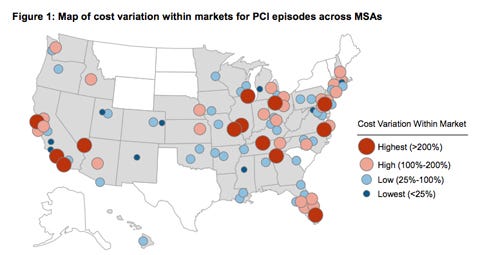A new report confirms wide variations in cost of a widely used medical device procedure not only throughout the nation but in local markets as well.
July 23, 2015

A new report confirms wide variations in cost of a widely used medical device procedure not only throughout the nation but in local markets as well.
Arundhati Parmar
A recent report on cost of angioplasties nationwide is enough to understand why payers are so keen to rein in costs of expensive procedures.
A study by Blue Cross Blue Shield Association and Blue Health Intelligence released last week shows that there are wide variations in how much a percutaneous coronary intervention or angioplasty costs in different areas of the country. Significant differences in cost can be seen even in the same market.
The report entitled "A Study of Cost Variation for Percutaneous Coronary Interventions (Angioplasties) in the U.S.” shows the median cost for an angioplasty was $27,144 in 86 of the 100 largest markets in the U.S. where BCBS claims data was available.
The procedure can cost as little as $15,494 in Birmingham, Alabama, and as much as $61,231 in Sacramento, California. Even within the same market, variations are noteworthy, the report found. For example, in the Los Angeles-to-Long Beach areaCalifornia, patients could pay any where between $10,749 and $67,937. That represents an eye-popping 532% cost variation.
The analysis is based on medical claims for nonMedicare BCBS members incurred for a period of three years ending March 2014 and paid through June 2014. The report doesn't delve too deeply into the the causes that are driving such variations, but did find that in markets with a high cost of variation a large volume of the procedures are taking place in facilities that are high-cost overall. However lower cost institutions are delivering quality outcomes at a lower price, the report found.
The chart below shows 12 metropolitan statistical areas (MSAs) where cost of percutaneous coronary interventions differs by more than 200%.

"Although some cardiac patients are not in a condition to shop for their procedure, the data show that many whose condition is less urgent have the ability to consider both quality and cost as they choose the best facility for their care," said Dr. Trent Haywood, chief medical officer for BCBSA, in a statement.
Arundhati Parmar is senior editor at MD+DI. Reach her at [email protected] and on Twitter @aparmarbb
To learn more about medical devices and trends in the marketplace, attend the two-day MEDevice San Diego conference, September 1-2 |
You May Also Like


